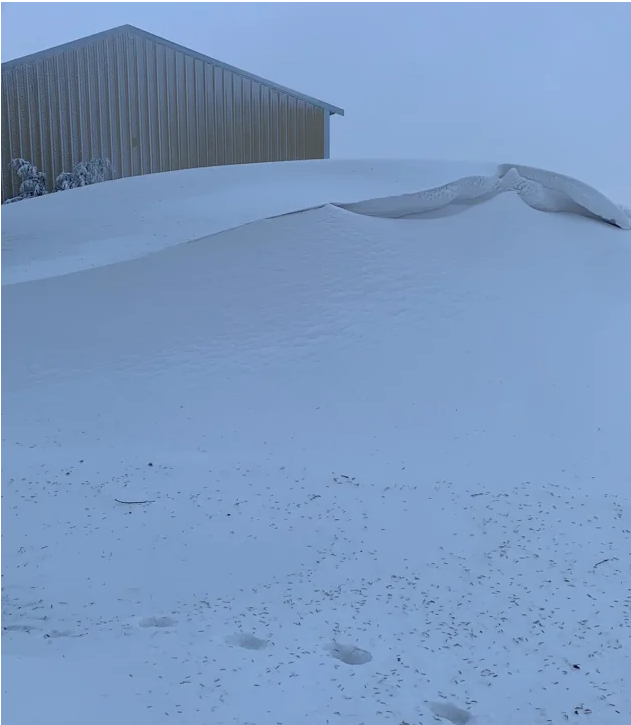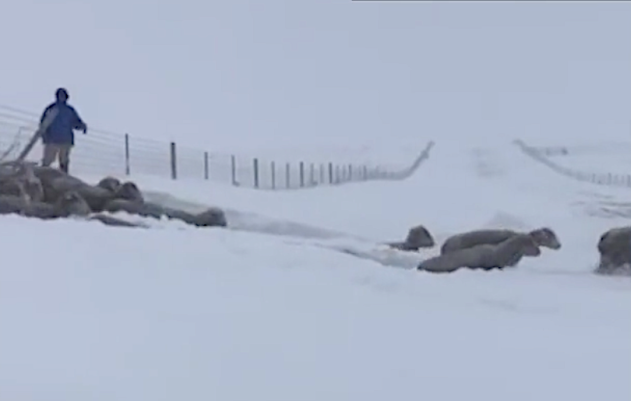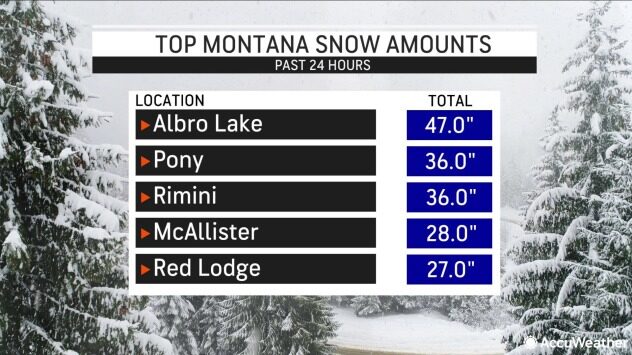
Hundreds of miles of roads were shut down, ranchers and their animals faced brutal conditions — and will see more tough weather ahead.
Meanwhile, snowdrifts in some spots were estimated to be higher than 10 feet in some places.
Sheep managed to find higher ground from being buried by a snowdrift on April 12 in Molt, Montana.
These sheep are built for snow but not for wind. All sheep are alive and accounted for.
The sun was out and shining Wednesday morning in Molt, Montana — a stark contrast to the blizzard conditions that had kept Sara Hollenbeck busy on her ranch, working to keep the wind and snow from burying her sheep.
The storm that delivered deadly severe weather to the South Central states buried those farther north in record-challenging snowfall and blizzard conditions.
A little more than a 30-minute drive from Hollenbeck Ranch, a record accumulation of 13.9 inches of snowfall was set at Billings, Montana, on Tuesday, breaking the old record of 5.8 inches set in 1991 and earning the title of the snowiest April day in the city since 1955. The mercury plunged to 10 degrees Fahrenheit, overtaking the old record of 15 F held since 1986. A total of nearly 11 inches of snow was reported roughly 10 miles east of Molt. The highest snowfall total in the state was an astounding 47 inches at Albro Lake in southwestern Montana.
It wasn't the snow alone that Hollenbeck was concerned about, however.
"Our sheep are built for snow, but if they get buried, nothing can survive unless we physically shovel them out, which, thank God, we didn't have to do," Hollenbeck told AccuWeather over social media.
The ranch's power supply, a lifeline through the storm, also managed to hold out. Without it, the water in the troughs would have frozen, leaving the livestock with nothing to drink.
Rancher Whitney Klasna, who owns Klasna Farms in Lambert, Montana, close to the North Dakota border, said it was difficult to gauge the snowfall amount with areas on her property ranging from the bare ground to four-foot drifts.
"We've spent the morning pushing snow out of the way so cows can get to water and feed more easily," she said. Thankfully, the wind had shifted out of the northwest, allowing natural protection from the landscape and shelterbelts to break wind gusts upwards of 30 mph.
Katelyn Dynneson-Larson, a rancher in Sidney, Montana, told AccuWeather via email that it was "a little western" where she was with drifts chest-high in places that blow in as soon as they're dug out.
"Today and tomorrow will be long days," Dynneson-Larson said Wednesday.
Snow was accumulating heavily near structures such as bridges in Noth Dakota due to the wind, the North Dakota DOT reported over Twitter. (Twitter/@NorthDakotaDOT)
The storm delivered record-challenging snowfall totals to areas from North Dakota to Nevada, including Bismarck, where 10 inches of snowfall on Tuesday buried the old daily record of 3 inches set back in 1991. An additional 6.5 inches of snow fell in Bismarck on Wednesday, just shy of the record of 6.6 inches from 1986. As of Wednesday, some of the highest estimates of accumulating snowfall in the state were recorded at Surrey and Grassy Butte at 22 inches.
Accumulating snowfall pitted the state's Department of Transportation against snowdrifts as the wind pushed snow up against structures such as bridges, and blizzard conditions forced several road closures. Numerous do not travel advisories were issued as well.
Just outside Hannaford, located in the eastern region of the state, farmer Justin Cambell and his family were careful to stock up on candles and fill the bathtub in the event that power was cut. Their electricity held out throughout the storm, which Cambell estimated delivered at least a foot of snow — though he added it was difficult to tell with the strong winds — and built towering snowdrifts.
"I can never remember a storm like this in April," Cambell, 34, told AccuWeather. "There was no snow in the yard yesterday morning. Now there is a drift that's halfway up our 20-foot pole shed."
Campbell said that his kids were sent home early from school on Tuesday, and classes were canceled Wednesday due to the poor roadway conditions and snowfall.
Public schools in Bismarck and Mandan were among those that were closed Tuesday, along with state facilities in Bismarck. North Dakota Gov. Doug Burgum activated the Emergency Operations Center to coordinate with local emergency managers across the state to help provide resources.
Officials urged motorists to avoid traveling on multiple major roads from the southwestern to northeastern corners of North Dakota, with long stretches closed off by Tuesday afternoon as blowing snow and near-zero visibility continued to cause dangerous driving conditions. On the North Dakota government website, a map of the state was nearly entirely red, reflecting the impassible roads.
One of the longest stretches of major roadway closed on Tuesday afternoon was a 240-mile stretch of US 2, from the Williston to Devil's Lake, North Dakota, in both directions, due to "life-threatening" conditions due to the low visibility and snow. Parts of I-94, US 83, US 85 and US 52 also remained closed due to the dangerous driving conditions.
In Grand Forks, near the Minnesota border, a 46-year-old man suffered "moderate injuries" after rear-ending a snowplow amid blizzard conditions, according to the Highway Patrol.
Early Wednesday, a state trooper and a North Dakota Department of Transportation (NDDOT) snowplow operator made a "blood run" from Minot to Bottineau, the North Dakota Highway Patrol (NDHP) said on Twitter. While the state highway patrol didn't release any specific details behind the transport, it said that occasionally troopers are requested to transport blood from one location to another when supplies are low.
Farther to the west, Pendleton, Oregon, saw a rare 1.9 inches of snowfall on Tuesday, making it the first measurable April snowfall in the area since April 1, 2009, when 0.5 of an inch fell.
While 0.8 of an inch of snow hardly seems as impressive in comparison, it was enough to tie with the old daily snowfall record set at Elko Regional Airport in Nevada on Tuesday. Temperatures also dropped to a record low of 7 degrees Fahrenheit at Ely Airport, Nevada, breaking the old record of 8 F set in 2001.
Meanwhile, temperatures nosedived in Akron, Colorado, at the Colorado Plains Regional Airport, which recorded roughly a 50-degree temperature drop. The mercury read 59 degrees Fahrenheit at 7:30 a.m., local time, on Tuesday, April 12, only to plummet to 6.8 F by 6:35 a.m. the next day.
Temperatures are forecast to remain low in the days following the blizzard, with AccuWeather RealFeel® Temperatures expected to plunge to 20 degrees below zero across Montana, Wyoming and the Dakotas from Thursday into Friday as a result of strong winds.
The lingering cold will mean that the jobs of ranchers like Dynneson-Larson and Klasna in those states won't be done even after the storm, as they'll have to keep an eye on newborn calves for any sign of pneumonia from the wet, cold conditions.
(Adriana Navarro, AccuWeather staff writer, contributed this report. It first appeared here on accuweather.com.)





Reader Comments